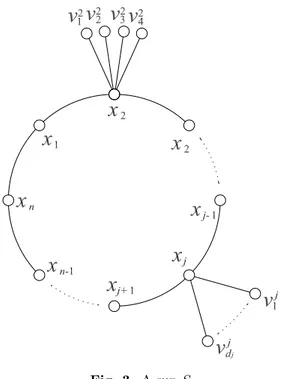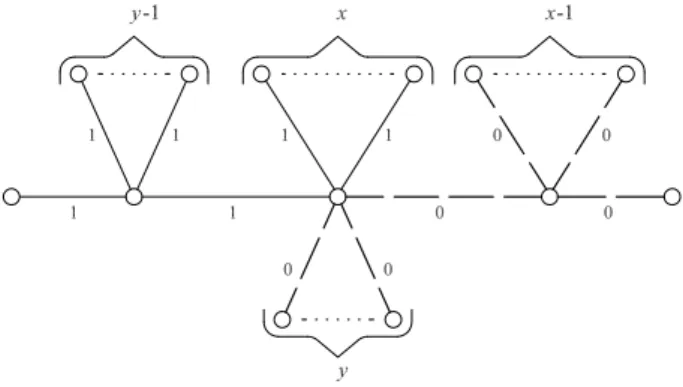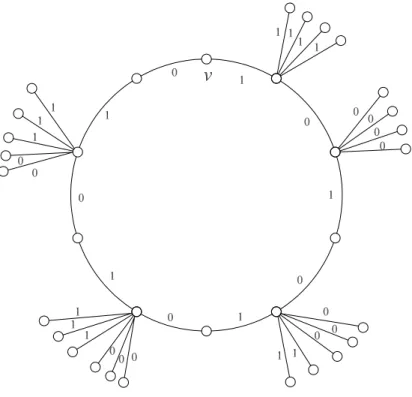Sylwia Cichacz
2-SPLITTABLE AND CORDIAL GRAPHS
Abstract. E. Miller and G.E. Stevens proved in [5] the existence of certain families of 2-splittable caterpillars. In this paper we characterize other families of 2-splittable caterpil-lars. Moreover, we show that for some of them there exists a friendly labeling inducing two isomorphic subgraphs.
Keywords: cordial graphs, 2-splittable graphs.
Mathematics Subject Classification: 05C78.
1. INTRODUCTION
All graphs considered in this paper are simple, finite and undirected. We use the standard terminology and notation of graph theory. Denote by |G| the order of graphG,|V(G)|, and bykGkthe size ofG,|E(G)|.
A graphGis2-splittableif its edge set can be partitioned into two subsets so that the induced subgraphs are isomorphic. This is equivalent to coloring the edges of the graph red and green so that the red subgraph is isomorphic to the green one ([5]). However we can color the graph by0 and1.
The problem of deciding whether a given graph is 2-splittable has been considered in several papers (see for example [5], [7]). This problem, even if restricted to trees, is NP-complete [4].
For a graphG = (V, E) define a binary labelling c : V(G) → Z2. Under such a labelling c, we letvc(i)denote the number of vertices in G that are labelledi. The labelling c is said to befriendly if|vc(1)−vc(0)| ≤1. The labelling c:V(G)→Z2 induces an edge labelling c∗:E(G)→Z
2 defined byc∗(xy) =|c(x) +c(y)|([6]). Let Ec∗(j) = {{x, y} :{x, y} ∈E and c(x) +c(y) =j} and ec∗(j) = |Ec∗(j)|. A graph
is said to becordial if it admits such a friendly labellingcthat |ec∗(1)−ec∗(0)| ≤1.
Cordial labelling was introduced by I. Cahit [1] as a weakened version of graceful labelling and harmonious labelling.
He also proved the following theorem:
Theorem 1.1 ([1]). The following families of graphs are cordial:
1. trees,
2. complete graphs Kn if and only ifn≤3,
3. complete bipartite graphs Kn,m for allm andn,
4. cycles Cn if and only ifn6≡2 mod 4.
However, N. Cairnie and K. Edwards proved that in a general case the problem of deciding whether or not a graphGis cordial is NP-complete [2].
We say that a labellingcinduces two isomorphic subgraphs if the subgraph with edges of label1 is isomorphic to the subgraph with edges with label0.
We are investigating the question of whether a 2-splittable graph can have a friendly labelling, which induces two isomorphic subgraphs. Obviously a neces-sary condition for the existence of such a friendly labelling of a graph Gis thatGis cordial. It is worth mentioning that there exists 2-splittable graphs (Fig. 1) for which there does not exist a friendly labelling inducing two isomorphic graphs, while they are cordial (by Theorem 1.1). Moreover, there exists some 2-splittable graphs which are not even cordial (for instance a cycleCn forn≡2 mod 4).
Fig. 1. Example of a2-splittable catrepillar
As in [5] acaterpillaris a tree in which all pedant edges are incident with vertices along a single path called thespine. The consecutive vertices of spine we denote as
x1, x2, . . . , xk. Pedant edges adjacent with the spine are legs. We assume that the
first (x1) and the last (xk) vertices of the spine has no legs and we will call these
vertices thehead andtail. We will refer to the edges of the spine incident with these vertices as the head andtail edges. We call the interior vertices incident with legs of the spinejointsand if a vertex has no legs incident with it we call it anub. For a joint
xi the end vertices of itsdi legs are denoted by vi1, v i 2, . . . , v
i
di (Fig. 2). A caterpillar T is anr-legged caterpillar if every joint has degreer+ 2 (i.e. every joint is incident with exactlyrlegs).
A graph S is a sun if the set of vertices of degree at least two induces a cycle
Cn =x1, x2, . . . , xn. Pendant edges adjacent with the cycle are called rays. As was
done above we call the interior vertices incident with rays of the cycle joints and if a vertex has no rays incident with it we call it a nub. For a jointxi the end vertices
of itsdi rays are denoted byvi1, v i 2, . . . , v
i
di (Fig. 3).
Fig. 3. A sunS
It is obvious that in order to be 2-splittable a graph has to have an even number of edges. E. Miller and G.E. Stevens have proved in [5] that there are some families of caterpillars for which this condition is also sufficient.
Theorem 1.2. All even sized single legged caterpillars and double legged caterpillars are 2-splittable.
In this paper we show some new families of2-splittable caterpillars and prove that for some of them there exists a friendly labelling inducing two isomorphic graphs.
2. MAIN RESULTS
Fig. 4. A non 2-splittable caterpillar
Theorem 2.1. A caterpillar T of an even size with a spine x1, x2, . . . , xk is
2-splittable with the head and tail edges belonging to different label classes, if the
following conditions are satisfied:
1. if consecutive joints have different degrees then the distance between them is at
least2, and
2. for each odd number d so that there is a joint with the degree d, there exists an
even number of joints with the degree d.
Moreover, if there exist only joints with an even degree, and there are no joints at
mutual distance one, then we can define a friendly labelling f :V(T)→Z2 inducing
an edge labelling f∗:E(T)→Z
2 defined byf∗(xy) =|f(x) +f(y)|. Furthermore, if k≡1 mod 4, thenf(x1) =f(xk).
Proof. Notice that because we have an even number of joints with an odd degree,
then there is an even number of edges in the spine x1, x2, . . . , xk, and it follows that k is odd. We can split the graph by alternately labelling the edges along the spine 0 and 1. Let f(x1) = 0, f(x2) = 1, f(xi) =f(xi−2) + 1 fori= 3, . . . , k. It follows
that f∗(xixi+1) = f∗(xi+1xi+2) + 1 for i = 1, . . . , k−2. Moreover f∗(x
1x2) = 1, f∗(xk
−1xk) = 0and ifk≡1 mod 4thenf(x1) =f(xk). Lethi=⌈ di
2⌉for allxi. We
start labelling end vertices of legs at the first joint and we use the following procedure: Let xi be a joint. If di+1 = 0, then let f(vi1) = . . . = f(vhii−1) = f(xi−1), f(vi
hi+1) =. . .=f(v i
di) =f(xi+1). If nowdiis even or among verticesx1, x2, . . . , xi−1
there exists an even number of joints such that they have the same degree asxi, then
letf(vi
hi) =f(xi−1). Assume now thatdiis odd and in verticesx1, x2, . . . , xi−1there
exists an odd number of joints such that they have the same degreedi. Letxj be such
that dj =di and there does not existxr such thatdr =di for r=j+ 1, . . . , i−1.
Now letf(vi
hi)have a label such thatf ∗(vi
hixi) =f ∗(vj
hjxj) + 1.
Assume nowdi+1 = di then letf(v1i) = . . . =f(vdii) = f(xi−1) and f(v i+1 1 ) = . . .=f(vdi+1i+1) =f(xi). Obviously the labelling f
∗:E(T)→Z2 induces two
isomor-phic subgraphs and one of them has label 1, whereas the other one has label 0 (see Fig. 5).
Notice that the spine of the caterpillar T is friendly labeled. Moreover, if there exists only joints with even degrees, and there does not exist joints at mutual distance one, then for any joint xi we have hi = d2i and f(v
i
1) = . . . = f(v i
hi) = f(xi−1), f(vi
hi+1) = . . . = f(v i
di) = f(xi+1) = f(xi−1) + 1. It implies that f is a friendly
Fig. 5. A labelling of a 2-splittable caterpillar
Notice that there exist caterpillars with consecutive joints at mutual distance one having the same degree such that there does not exist friendly labelling inducing two isomorphic subgraphs, see Figure 1.
It is worth noticing that there are infinitely many 2-splittable caterpillars which have consecutive joints with different degrees with distance one between them (see Fig. 6).
Fig. 6. A 2-splittable caterpillar
Remember that by Theorem 1.1 for a cycleCn with n≡2 mod 4there does not
exist a friendly labelling inducing two isomorphic subgraphs. Theorem 2.1 implies easily:
Theorem 2.2. An even sized sunS with a cycle Cn=x1, x2, . . . , xn is2-splittable,
if the following conditions are satisfied:
1. if consecutive joints have different degrees then the distance between them is at
least2, and
2. for each odd number d so that there is a joint with the degree d, there exists an
even number of joints with the degree d.
Moreover, if there are only joints with even degrees, any two of them at distance at least two apart andn≡0 mod 4, then we can define a friendly labellingf :V(S)→Z2
inducing an edge labelling f∗:E(S)→Z2 defined by f∗(xy) =|f(x) +f(y)|.
Proof. Notice that if there exists any nubv in the sunSthen we can split that sun at
It implies that the caterpillarT is2-splittable with the head and tail edges belonging to different label classes. Since we do not care now about labels of vertices, we can glue together the head and tail of T and see that the sun S is 2-splittable (see Fig. 5 and 7). Moreover if we use the labelling (of vertices) defined in Theorem 2.1, then if n ≡ 0 mod 4 and there exist only joints with even degrees, and any two of them are at distance at least two apart, thenf is a friendly labelling ofS.
Fig. 7. A 2-splittable sun
Therefore, we can assume that there is no nub in the sun S. Since the size ofS
is even it follows by our assumption that there is an even number of joints and all of them have the same degree. Define now f∗ : E(S) →Z
2 as follows: f∗(x1x2) = 0, f∗(xi+1xi+2) =f∗(xixi+1) + 1,f∗(vi
1xi) =. . .=f∗(vdiixi) =f∗(xixi+1)for alli. We
can see that the edge labelling f∗ induces two isomorphic subgraphsS
0, S1 ofS of
labels0 and1, respectively, and the theorem is proved.
3. CONCLUSIONS
Acknowledgments
My sincere thanks are due to Professor D. Froncek for help concerning the preparation of this paper. The work was partially supported by Fulbright Scholarship nr 15072441 and a grant N201 1247/33.
REFERENCES
[1] I. Cahit,Cordial graphs: a weaker version of graceful and harmonious graphs, Ars Com-bin23(1987), 201–207.
[2] N. Cairnie, K. Edwards,The computational complexity of cordial and equitable labelling, Discrete Mathematics216(2000), 29–34.
[3] Y.-S. Ho, S.-M. Lee, H.-K. Ng,On friendly index sets of root-unions of stars by cycles, Journal of Combinatorial Mathematics and Combinatorial Computing62(2007), 97–120.
[4] D.S. Johnson,The NP-completness column: an ongoing guide, Journal of Algorithms3
(1982), 288–300.
[5] E. Miller, G.E. Stevens, Some graphs for which even size is sufficient for splittability, Congressus Numerantium173(2005), 137–147.
[6] E. Salehi, Sin-Min Lee, On friendly index sets of trees, Congressus Numerantium178
(2006), 173–183.
[7] G.E. Stevens,Some caterpillars are 2-splittable, Congressus Numerantium104(1994), 181–186.
Sylwia Cichacz cichacz@agh.edu.pl
AGH University of Science and Technology Faculty of Applied Mathematics
al. Mickiewicza 30, 30-059 Kraków, Poland
University of Minnesota Duluth Duluth, MN 55812-3000 U.S.A.



